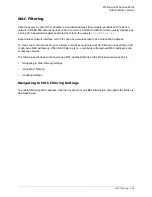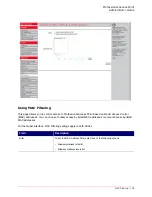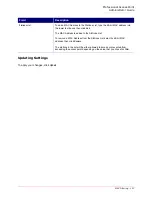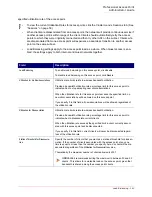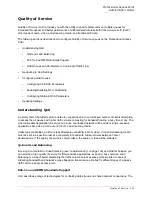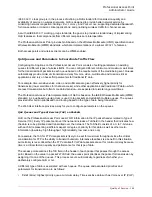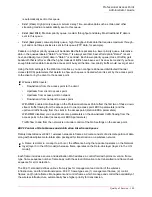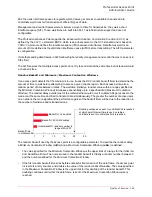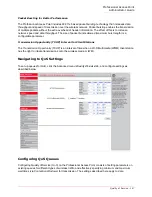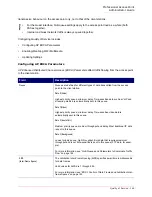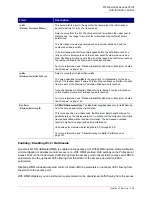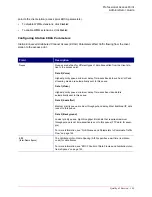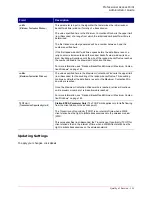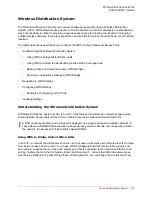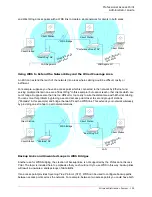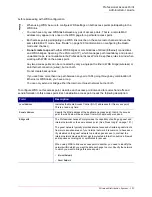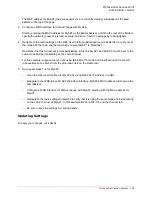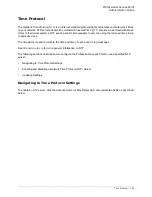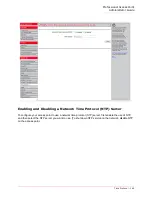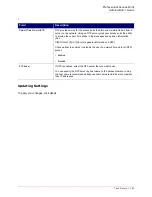
Professional Access Point
Administrator Guide
Quality of Service - 149
Enabling/Disabling Wi-Fi Multimedia
By default, Wi-Fi MultiMedia (WMM) is enabled on the access point. With WMM enabled, QoS prioritisation
and coordination of wireless medium access is on. With WMM enabled, QoS settings on the Professional
Access Point control
downstream
traffic flowing from the access point to client station (access point EDCA
parameters) and the
upstream
traffic flowing from the station to the access point (station EDCA
parameters).
Disabling WMM will deactivate QoS control of station EDCA parameters on
upstream
traffic flowing from
the station to the access point
With WMM disabled, you can still set some parameters on the downstream traffic flowing from the access
cwMin
(Minimum Contention Window)
This parameter is input to the algorithm that determines the initial random
backoff wait time for retry of a transmission.
Select a value from the list. The value selected for
cwMin
is the upper limit, in
milliseconds, of a range from which the initial random backoff wait time is
determined.
The first random number generated will be a number between 0 and the
number specified in
cwMin
.
If the first random backoff wait time expires before the data frame is sent, a
retry counter is incremented and the random backoff value (window) is dou-
bled. Doubling will continue until the size of the random backoff value reaches
the number defined in the Maximum Contention Window.
For more information, see “Random Backoff and Minimum / Maximum Conten-
tion Windows” on page 146.
cwMax
(Maximum Contention Window)
Select a value that is higher than
cwMin
.
The value specified for
cwMax
is the upper limit, in milliseconds, for the dou-
bling of the random backoff value. This doubling continues until either the data
frame is sent or the Maximum Contention Window size is reached.
Once the Maximum Contention Window size is reached, retries will continue
until a maximum number of retries allowed is reached.
For more information, see “Random Backoff and Minimum / Maximum Conten-
tion Windows” on page 146.
Max. Burst
(Maximum Burst Length)
AP EDCA Parameter Only
. The
Max. Burst Length
applies only to traffic flowing
from the access point to the client station.
This value specifies, in milliseconds, the Maximum Burst Length allowed for
packet bursts on the wireless network. A
packet burst
is a collection of multiple
frames transmitted without header information. The decreased overhead
results in higher throughput and better performance.
Valid values for maximum burst length are 0.0 through 999.9.
For more information, see “Packet Bursting for Better Performance” on
page 147.
Field
Description
Summary of Contents for Instant802 APSDK
Page 1: ...Professional Access Point Administrator Guide R46 1224 00 rev 2 0 07 06...
Page 2: ......
Page 4: ...Professional Access Point Administrator Guide iv...
Page 8: ...Professional Access Point Administrator Guide viii...
Page 42: ...Professional Access Point Administrator Guide Basic Settings 42...
Page 52: ...Professional Access Point Administrator Guide Access Points 52...
Page 58: ...Professional Access Point Administrator Guide User Management 58...
Page 62: ...Professional Access Point Administrator Guide Sessions 62...
Page 70: ...Professional Access Point Administrator Guide Channel Management 70...
Page 88: ...Professional Access Point Administrator Guide Neighboring Access Points 88...
Page 96: ...Professional Access Point Administrator Guide Ethernet Wired Settings 96...
Page 120: ...Professional Access Point Administrator Guide Security 120...
Page 128: ...Professional Access Point Administrator Guide Virtual Wireless Networks 128...
Page 134: ...Professional Access Point Administrator Guide Radio 134...
Page 138: ...Professional Access Point Administrator Guide MAC Filtering 138...
Page 152: ...Professional Access Point Administrator Guide Quality of Service 152...
Page 160: ...Professional Access Point Administrator Guide Wireless Distribution System 160...
Page 164: ...Professional Access Point Administrator Guide Time Protocol 164...
Page 170: ...Professional Access Point Administrator Guide SNMP 170...
Page 290: ...Professional Access Point Administrator Guide Configuration Troubleshooting 290...
Page 298: ...Professional Access Point Administrator Guide Regulatory Information 298...
Page 328: ...Professional Access Point Administrator Guide Index 328...

